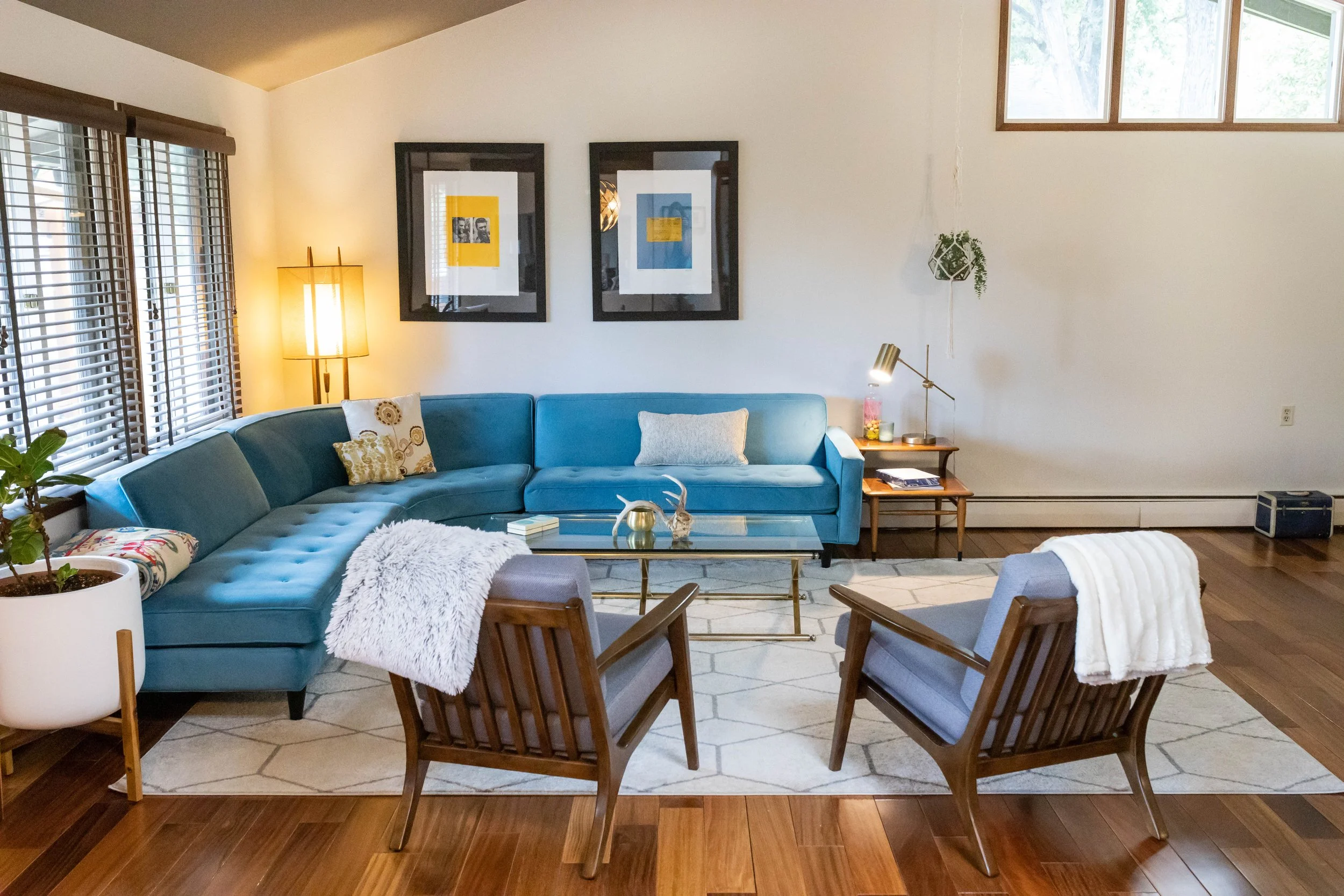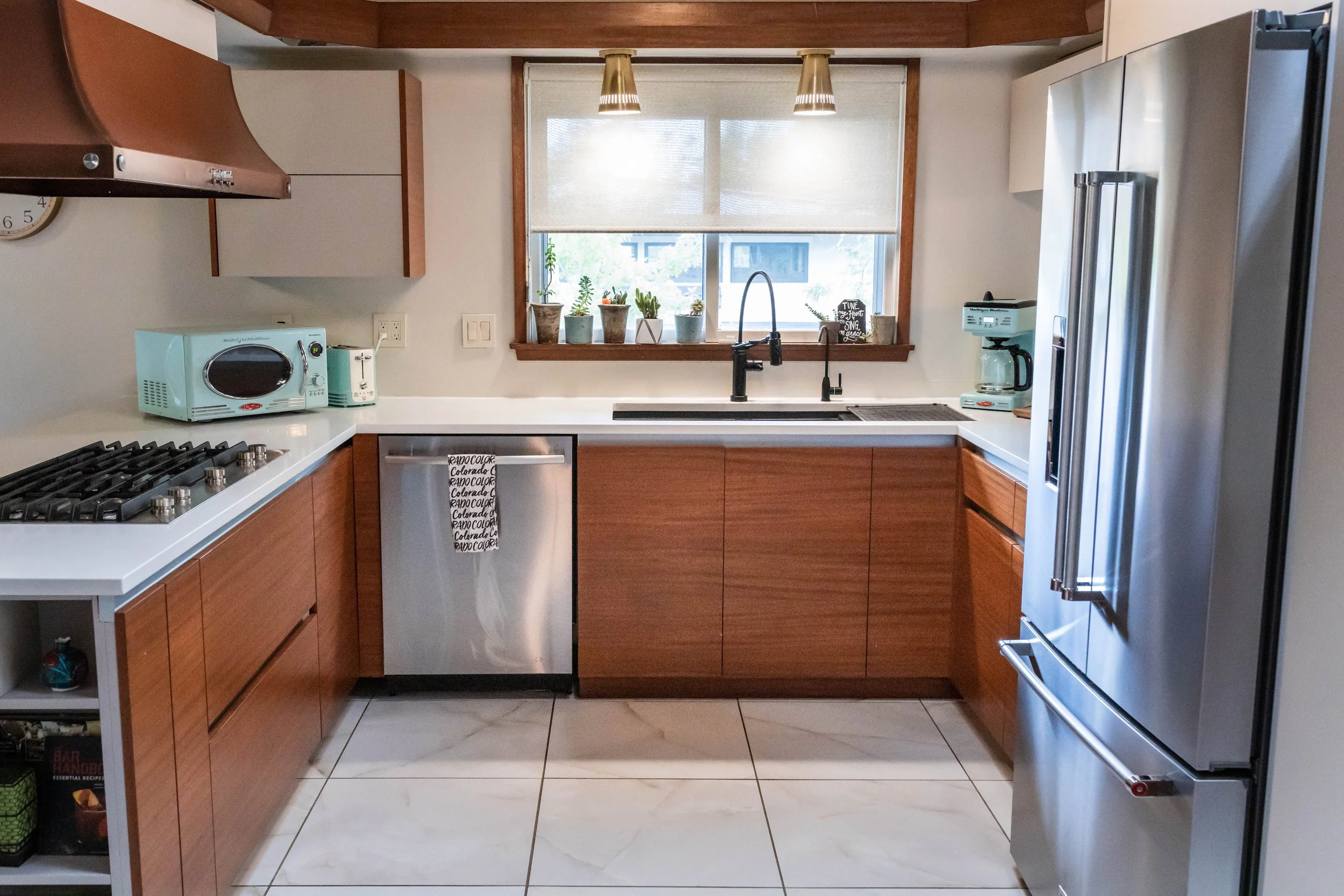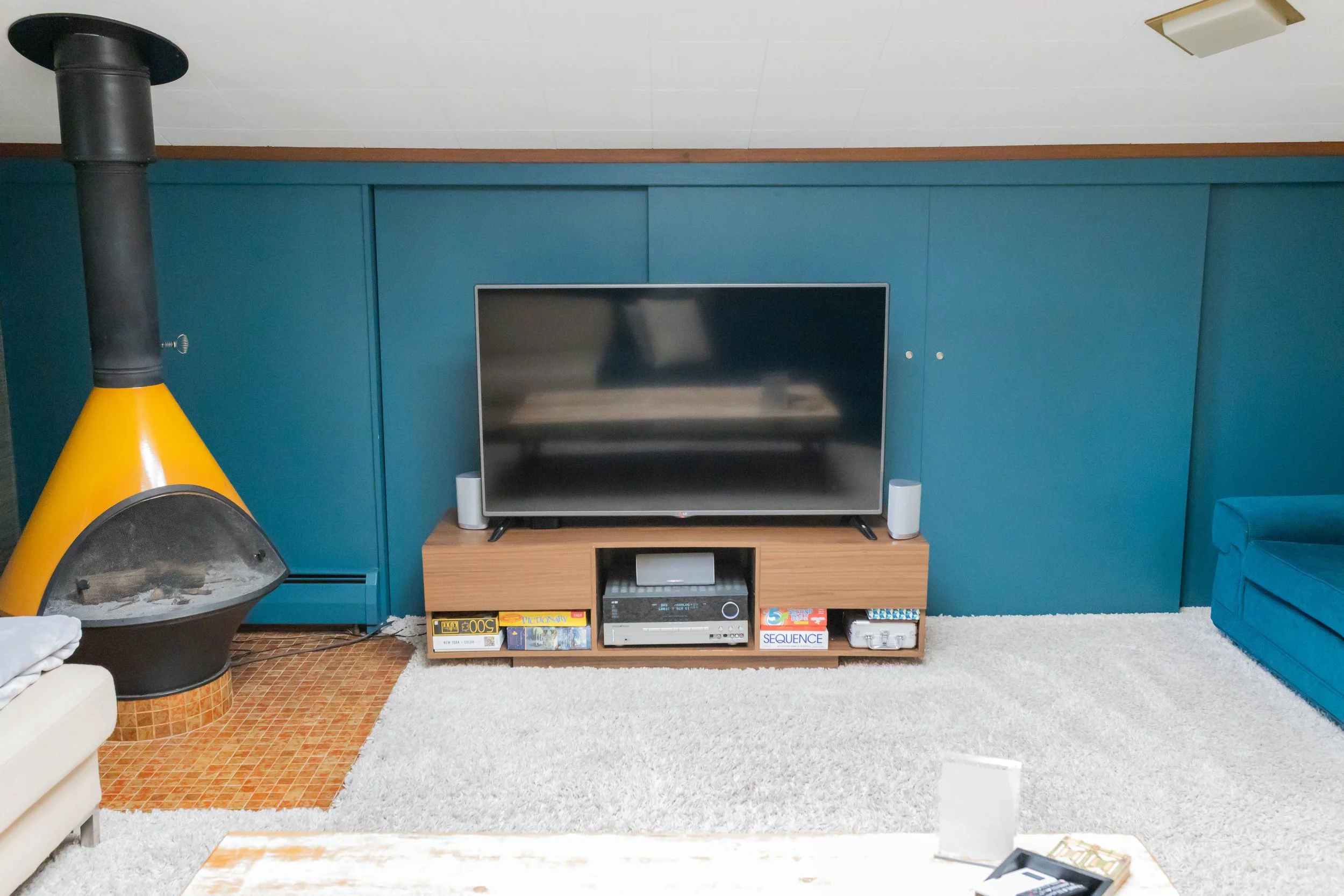Why This Mid-Century Home Works: A Case Study in Thoughtful Design
See how a 1965 Charles Zecher home blends vintage soul with modern function — a case study in updating mid-century design without losing its character.
The curved turquoise sectional and walnut accent chairs sourced from Scandinavian Designs. Artwork by Jeff Scott. MCM floor lamp designed by Adrian Pearsall.
There’s something special about a home that still carries the rhythm of its era. When I first stepped into Justin and Autumn Williams’ mid-century modern home, designed by Charles Zecher in 1965, it felt like time travel in the best way—original details intact, architectural lines still proud, and updates so respectful you almost miss them.
While Justin handled nearly every detail of the renovation and design himself, I had the joy of helping stage the home to capture its full character. This house quickly became one of my favorite examples of how to update a mid-century home without erasing its soul.
A Funky Find in a Quiet Neighborhood
Justin wasn’t just house hunting—he was searching for a feeling.
“We were looking for a house that looked like something the Brady Bunch had lived in,” he told me. “Something funky—mid-century—with multiple split levels. This checked all the boxes.”
Designed by Charles Zecher, the home sits in a quiet neighborhood with just a handful of mid-century builds among more traditional houses. That contrast made it even more appealing.
“I did research on every MCM neighborhood,” Justin said, “and when this one came on the market, it stood out because it was a one-off in a normal neighborhood. That made me like it even more.”
Updated address signage and vibrant daylilies bring a cheerful, retro charm to the front approach—perfectly complementing the home’s iconic lines and bold palette.
Architect Charles Zecher’s 1965 design shows its playful geometry from the start—sloped rooflines, vertical siding, and a bold chartreuse façade that feels both sculptural and welcoming.
Updating With Integrity
Many mid-century homes require balancing preservation with livability, and Justin achieved that with remarkable sensitivity. His updates feel seamless—modern where necessary, but always in conversation with the home’s original design.
“It was already livable—we just updated things that needed to be replaced, like appliances, while keeping some things intact, like the vent hood in the kitchen because it still worked and was so unique.”
The kitchen, with its open semi-open concept, walnut cabinetry, and crisp white countertops, captures that balance perfectly. Its geometric detail nods to Zecher’s architectural lines while introducing a brighter, more functional space for everyday use. Across the house, warm walnut tones tie new and old together—seen in the trim, built-ins, and even the furniture—preserving the rhythm of the original millwork.
He tackled every update himself.
“I was the designer and the GC for the updates.”
The kitchen’s cabinetry, for example, was reproduced to match the original trim.
“I worked with a cabinet company to recreate the look of the original wood trim for our kitchen cabinets,” he said.
The kitchen before the updates.
Updated kitchen with walnut cabinets, clean white countertops, and new appliances. Vent hood and stove top original to the house.
Designer’s Note: The best updates feel inevitable—like they’ve always belonged there. That’s what makes a renovation feel timeless.
In the living spaces, the furnishings echo the home’s playful MCM spirit. The curved turquoise sofa and low, wood-framed lounge chairs mirror the era’s organic shapes without feeling theme-y. Paired with textural rugs, brass accents, and soft neutrals, they bring warmth and cohesion to the open plan.
And while many homeowners rush to strip out older features, Justin took the opposite approach.
“We loved the unique look of the loft with shag carpet and decided not to touch it.”
A vintage Malm fireplace and shag carpet, both original to the home, updated with MCM furniture and teal painted closet panel doors.
Stories Hidden in the Walls
Like most MCM homes, this one came with its share of surprises—both architectural and personal.
“There was an ornate wooden cross that came with the house,” Justin shared. “The original owner who designed the house built a small version that was later scaled up into a large cross for a local church.”
Another discovery came in the form of a mysterious cutout in the living room wall.
“When I asked the original owner’s son about it, he said his dad built it to hold card tables for when they had friends over to play bunco.”
Details like these remind us that mid-century homes weren’t just designed for form—they were built for connection.
The living room features built-in bookshelves with grasscloth shutters to hide the TV, a brass fireplace, and clerestory windows to bring in natural light from above.
When asked which space feels most “him,” Justin didn’t hesitate.
“The kitchen. Probably because I designed it.”
But he also has a soft spot for the upper loft—a playful, nostalgic corner of the house.
“It almost feels like an adult treehouse with shag carpet,” he said. “I love that.”
And his favorite object?
“The MCM floor lamp—it’s very unique and rare.”
These personal details ground the house in lived-in warmth, not museum perfection.
Design Wisdom From a Thoughtful Owner
When I asked what advice he’d offer to others updating a mid-century home, Justin’s answer summed up everything this house represents:
“I would ask the home what it wants—not necessarily what you want. We’re all just living in it for a set time, and eventually someone else will live there. So while we updated the kitchen, it looks like it was part of the original design. I have to tell people it was updated because it looks timeless.”
Then he added, with passion that any MCM purist would applaud:
“The biggest failure I see are people who buy MCM and flip them using Ikea cabinetry. That guts the soul of the home. It shows they don’t respect mid-century homes—they’re just making money.”
His perspective captures what I love most about good design: when updates feel invisible, when new and old blend so seamlessly that the house itself still feels whole.
This 1965 Zecher home stands as a beautiful reminder that the heart of mid-century modern design isn’t just in the lines or materials—it’s in the respect for craftsmanship, history, and the quiet humility of design made to last.
Justin’s approach—preserving where possible, modernizing where necessary—embodies the kind of stewardship MCM homes deserve.
“Ask the home what it wants.”
That might just be the best design advice I’ve heard all year.
Playful art and classic furniture silhouettes bring personality without overpowering the architecture. The split-level layout keeps sightlines open and connected.
Art — A Long-Term Relationship
I’ve been on a journey lately of understanding art more richly and learning how to collect art. As an interior designer, I often look for art pieces for my clients, and I’d like to think I do a pretty good job for the projects I’ve been given. But when it comes to my own home, I feel utterly stuck. Every now and then I’ll find something I like and put it on the wall. Six months later, I want to change it out and have to start all over again. I become overwhelmed by the number of options and can’t decide what will pass the “six-month wall test.” I also don’t have any pieces that have been a true investment—nothing that makes my wallet hurt a little, nothing I couldn’t buy without sleeping on it first. So here I am, with some of my thoughts, learnings, and observations of art and how to find it.
Some quotes from Oscar Wilde that capture the purpose of art:
“Art is the most intense mode of individualism that the world has known.”
“What art seeks to disturb is monotony of type, slavery of custom, tyranny of habit, and the reduction of man to the level of a machine.”
Leo Tolstoy’s thoughts on art from What Is Art?:
“Art begins when a man, with the purpose of communicating to other people a feeling he once experienced, calls it up again within himself and expresses it by certain external signs.”
And, “If only the spectators or auditors are infected by the feelings which the author has felt, it is art.”
What distinguishes good art from mere paint on a canvas (or any other medium)?
Here are some criteria I’ve gathered and expanded on, drawing from sources like Tolstoy, Wilde, Aristotle, Plato, Kant, and various schools of thought:
Expressiveness — Art should create an emotional impact on the viewer, evoking a feeling. Tolstoy describes this as the “infection” of feeling—when the artist’s inner experience is successfully communicated to the viewer.
Originality — Oscar Wilde emphasizes breaking away from tradition and embracing individuality.
All art is imitated in some form, though. An artist might use the same paint color as another artist or piece. They might create a similar shape or form. What makes it original is when it says something different than what’s been said before. This is different than when you’re looking for art pieces that are an “original” piece of art. You can usually find the artist’s signature and date and sometimes an edition or print number on the back of the piece to see if it’s original or not.
Craftsmanship & Skill — This sets the baseline for “well-made” art.
It can be disheartening to see poorly made works sold for thousands. Abstract art, in particular, often attracts these types of pieces. When a work shows clear evidence of time, patience, and mastery, you can see it in the details—the harmony of its components and the intentionality behind it. However, technical skill alone isn’t enough. A perfectly executed piece can still feel hollow if it lacks emotional or intellectual depth.
Communicating Meaning or Insight — Madeleine L’Engle says in her book Walking On Water, “Art is communication, and if there is no communication it is as though the work had been stillborn.” Art can engage with themes of culture, humanity, and society. When it sparks conversation, it’s doing its job. Sometimes, art is purely aesthetic, and that’s okay. But when a piece tries to communicate a deeper concept yet is so abstract that it loses its audience, its message can get lost.
Beauty — Immanuel Kant said, “The beautiful is what pleases universally without a concept.” When color, form, rhythm, balance, and harmony work together, they create a sensory experience that makes us call something beautiful.
Sincerity — I love this one because it feels personal to me, as it should, and a little bit uncomfortable, as it should. Art should not be a formula or something from which to merely make money. That means it requires something from the artist. It requires honesty, belief in their work, and authenticity to themselves. I would say sincerity and authenticity are also components of what make a piece original. It keeps us from getting shallow work that is just “made for show.”
Problem we might face in finding good art: how do you verify if a piece is sincere or if the artist believes in their work? Oftentimes, you can talk to the artist and get a good sense of their values and sincerity. And most of the time, the art will speak for itself. Is it trying to be like another work of art or follow a trend? Or does it feel sincere?
Impact — A piece with lasting relevance that resonates across different time periods has true impact. Some art fades because it was trendy or tied too closely to its era. Other works—like classical masterpieces or Picasso’s Cubist paintings—continue to captivate new audiences decade after decade. That staying power signals legacy.
I know a lot of this sounds abstract, but art is exactly that. It is complex because every work of art created by a human being carries at least some part of the complexity of that human being. Just as no thumbprint is the same, each piece of art will be different.
It takes time and patience to identify these things and discover what you might find to be “good art.” Ultimately, it comes down to how a piece speaks to you:
How does it make you feel?
What does it make you think about?
Do you appreciate the craftsmanship and form?
I’m still on that journey and hope to fail over and over again so I can become even more challenged in my understanding and relationship with art.
If you’re reading this, thank you for coming along with me. I’ll be back soon with updates on my own art collection!
Midcentury Modern Design: Why This Iconic Style Stands the Test of Time
Midcentury modern design has captivated homeowners, designers, and architects for decades—and for good reason. With its clean lines, organic influences, and timeless functionality, this design style continues to feel fresh and relevant, whether it’s featured in a 1950s ranch or a newly built home today.
But how did this style come about? And why does it remain such a go-to choice for those who crave both style and comfort? Let’s dive into the history, key influencers, and practical ways to bring midcentury modern (MCM) into your own home.
A Brief History of Midcentury Modern Design
Midcentury modern design emerged in the mid-20th century (roughly 1945–1970) as a response to a rapidly changing world. After World War II, there was a surge in optimism, innovation, and suburban growth. Designers sought to create homes and furnishings that were affordable, functional, and stylish—breaking away from overly ornate prewar styles.
This era brought together advances in materials (like molded plywood, fiberglass, and tubular steel) with a focus on simplicity and livability. The result? A design style that balanced sleek minimalism with warmth and comfort, making it both beautiful and practical.
Influential Midcentury Modern Designers and Architects
Several visionaries shaped the movement, leaving a lasting imprint on architecture and interiors alike:
Charles and Ray Eames – Known for their innovative furniture designs, particularly the iconic Eames Lounge Chair and Molded Plywood Chair, which emphasized comfort without sacrificing style.
Eero Saarinen – Architect and furniture designer, creator of the famous Tulip Table and the Gateway Arch in St. Louis.
George Nelson – A design director at Herman Miller, he gave us classics like the Nelson Bench and the whimsical Bubble Lamp.
Arne Jacobsen – Danish architect and designer, best known for the Egg Chair and Swan Chair, which merged sculptural beauty with functionality.
Richard Neutra – Architect recognized for his sleek, glass-heavy homes in California that blurred the line between indoors and outdoors.
These pioneers not only influenced how homes looked but also how people lived—emphasizing connection to nature, open layouts, and furniture designed for real everyday life.
Essential Elements of Midcentury Modern Design
What makes this style so recognizable—and timeless? Here are the hallmarks:
Clean, Straightforward Lines – Furniture and architecture emphasize function and simplicity, often with tapered legs and uncluttered silhouettes.
Organic and Geometric Shapes – Think sculptural chairs, bold angles, and rounded edges that feel playful yet refined.
Natural Materials – Warm woods like teak, walnut, and oak play a starring role, often paired with leather, metal, or glass.
Integration with Nature – Large windows, open floor plans, and indoor-outdoor flow connect living spaces with their surroundings.
Pops of Color – Neutrals form the base, accented with vibrant hues like mustard yellow, burnt orange, or teal.
Easy Ways to Bring Midcentury Modern Style Into Your Space
You don’t need to live in a midcentury house to enjoy this timeless aesthetic. Here are some approachable tips:
Start with Furniture – Choose a few iconic pieces with clean lines and tapered legs. Even a single statement chair can transform a space.
Embrace Wood – Incorporate warm-toned woods in your furniture, shelving, or even accent paneling.
Play with Color – Use a neutral base (white, gray, or beige) and add bold accent colors through pillows, art, or rugs.
Layer Lighting – Look for globe pendants, tripod floor lamps, or sconces inspired by midcentury designers.
Add Art and Decor – Geometric prints, abstract artwork, and sculptural ceramics are all very MCM.
Keep It Functional – Remember, midcentury design is all about livability. Avoid clutter and choose pieces that are as practical as they are beautiful.
Why Midcentury Modern Endures
Midcentury modern continues to thrive because it strikes a perfect balance—minimal without being cold, bold without being overwhelming, and functional without being boring. Its adaptability allows it to blend seamlessly into different homes and lifestyles, proving that good design truly never goes out of style.
Whether you’re furnishing a cozy living room or reimagining an entire home, midcentury modern offers a timeless roadmap for creating spaces that feel both stylish and welcoming.










